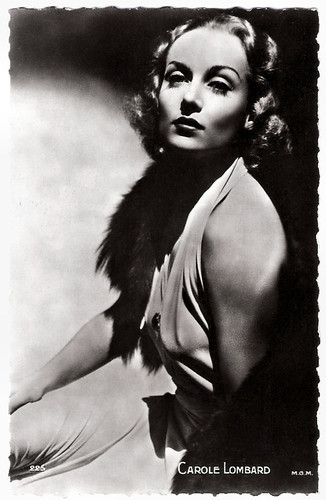
French postcard by Editions P.I., no. 225. Photo: M.G.M.

British Art Photo postcard, no. 20. Photo: Paramount Pictures.
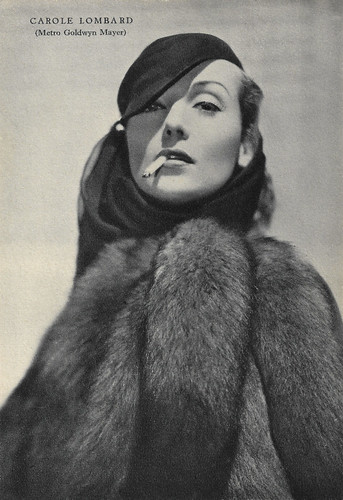
Italian postcard by Rizzoli & C., Milano, 1938-XVI. Photo: Metro-Goldwyn-Mayer (MGM). Carole Lombard in The Princess Comes Across (William K. Howard, 1936).
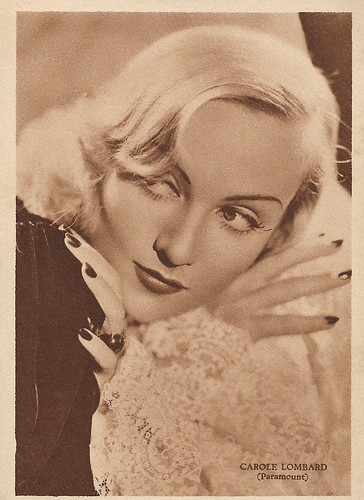
Italian postcard by Rizzoli & C., Milano, 1940. Photo: Paramount.

British postcard by Valentine's in the Film Stars and Their Pets series, no. 5843 D. Photo: Paramount.
A free-spirited tomboy
Carole Lombard was born as Jane Alice Peters into a wealthy family in Fort Wayne, Indiana, in 1908. In 1916 the family decided to settle down in the Los Angeles area.
She attended Virgil Junior High School. Described by her biographer Wes Gehring as 'a free-spirited tomboy', the young Lombard was passionately involved in sports and enjoyed watching films. While playing baseball in the street with the neighbourhood boys, she was spotted by film director Allan Dwan.
This led to her screen debut at 12, a small role in Dwan's A Perfect Crime (Allan Dwan, 1921), playing the sister of Monte Blue. Although she tried for other acting jobs, she would not be seen onscreen again for four years. She returned to a normal life, going to school and participating in athletics, excelling in track and field.
In 1924 or 1925 (the sources differ, she passed a screen test and was signed to a contract with Fox Films. Her first role as a Fox player was Hearts and Spurs (W.S. Van Dyke, 1925), in which she had the female lead opposite Buck Jones.
She got her first break the following year in another leading role opposite Edmund Lowe in the successful drama Marriage in Transit (Roy William Neill, 1925). She was credited now as 'Carol Lombard'. After a car accident in 1926 that left a scar on the left side of her face, she was dropped by Fox.
The 17-year-old had an early plastic surgery procedure to make it less visible. For the remainder of her career, Lombard learned to hide the mark with make-up and careful lighting. After a year without work, Lombard obtained a screen test for the 'King of Comedy' Mack Sennett. He offered her a contract, and although she initially had reservations about performing in slapstick comedies, the actress joined his company as one of the 'Bathing Beauties'.
Lombard appeared in 15 short Sennett productions between September 1927 and March 1929. When sound film was introduced, her light, breezy, sexy voice perfectly suited the talkies. Her first sound film was High Voltage (Howard Higgin, 1929), soon followed by another crime film The Racketeer (Howard Higgin, 1929).
After a successful one-off appearance opposite Warner Baxter in Fox's The Arizona Kid (Alfred Santell, 1930), she signed a contract with Paramount Pictures who cast her in the Buddy Rogers comedy Safety in Numbers (Victor Schertzinger, 1930). For her second assignment, the romantic comedy Fast and Loose (Fred C. Newmeyer, 1930) with Miriam Hopkins, Paramount mistakenly credited the actress as 'Carole Lombard'. She decided she liked this spelling and it became her permanent screen name.

British postcard in the Film Kurier Series, London, no. 45. Photo: Paramount Pictures.

British postcard.

British postcard by De Reszke Cigarettes, no. 8. Photo: Paramount.

British postcard by Valentine's in the Film Stars and Their Pets series, no. 5843 D. Photo: Paramount.

British Real Photograph postcard, no. 45.a. Photo: Paramount Pictures.
The highest-paid actress in Hollywood
Carole Lombard began appearing in comedies with William Powell such as Man of the World (Richard Wallace, 1931) and Ladies Man (Lothar Mendes, 1931) and married him in June 1931. The marriage to Powell, Paramount's top male star, increased Lombard's fame. Although they divorced in 1933, the two would continue to occasionally star together throughout the 1930s.
Lombard starred for the first and only time alongside Clark Gable (they married in 1939) in the romantic drama No Man of Her Own (Wesley Ruggles, 1932). The successful screwball comedy Twentieth Century (Howard Hawks, 1934) with John Barrymore, showed her true comedic talents and proved to the world what a fine actress she really was.
It was followed by the hit comedies Hands Across the Table (Mitchell Leisen, 1935) with Fred MacMurray, The Princess Comes Across (William K. Howard, 1936), My Man Godfrey (Gregory LaCava, 1936), which won her an Academy Award nomination opposite Powell, Swing High, Swing Low (Mitchell Leisen, 1937), and Nothing Sacred (William Wellman, 1937).
By then Lombard had become the highest-paid actress in Hollywood and one of its most popular stars. Eager to win an Oscar, by the end of the decade she began to move away from comedies towards more serious roles, appearing opposite James Stewart in the drama Made for Each Other (John Cromwell, 1939) and alongside Cary Grant in the romance In Name Only (John Cromwell, 1939).
Her role as a nurse in Vigil in the Night (George Stevens, 1940) was her most notable attempt to win an Oscar but didn't receive a nomination. Lombard returned to comedy in Alfred Hitchcock's Mr. & Mrs. Smith in 1941. Lombard's career was cut short when she died at the age of 33 in an aircraft crash.
On January 16, 1942, Carole, her mother, and 20 other people were flying back to California when the plane went down outside of Las Vegas, Nevada. All aboard perished. Her final film, Ernst Lubitsch's To Be or Not to Be (1942), a satire about Nazism and the war, was in post-production at the time of her death. Wikipedia: "Today she is remembered as one of the definitive actresses of the screwball comedy genre and American comedy and ranks among the American Film Institute's greatest stars of all time."

French postcard by A.N., Paris, no. 1124. Photo: Paramount.
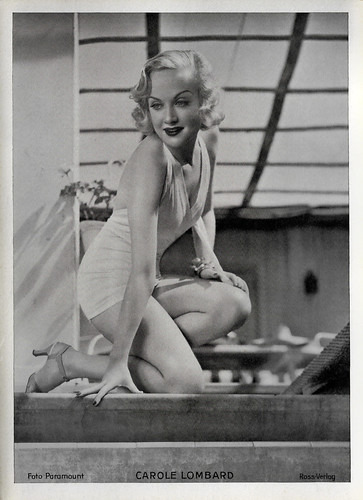
Big German card by Ross Verlag. Photo: Paramount.

German collectors card in the Bunte Filmbilder series by Greilingen-Zigaretten, Series no. 2, no. 259. Photo: Paramount / Ross-Verlag.
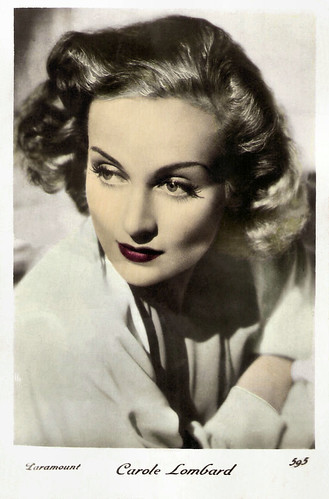
French postcard, no. 595. Photo: Paramount.
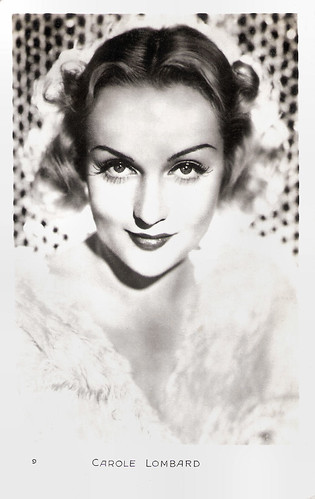
Vintage card, no. 9.
Sources: Wikipedia and IMDb.
No comments:
Post a Comment